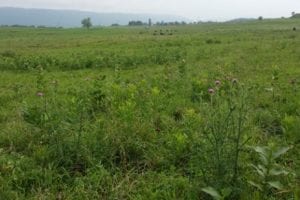– Dwight Lingenfelter, Extension Associate, Weed Science, Penn State and William S. Curran,Ph.D., Emeritus Professor of Weed Science, Penn State
Fall is an excellent time to manage biennial and perennial weeds. In particular, biennials such as common burdock, wild carrot, and bull, musk, and plumeless thistles are much easier to kill while they are in the rosette stage of growth, prior to surviving a winter. Once biennials start growth in the spring they rapidly develop with the goal of reproducing and it becomes more difficult to control them.

As you have heard many times before, late summer and fall is the best time to control most perennials with a systemic herbicide they move into root systems allowing better control. In general, the application window runs from early September through October depending on your location and what weeds you are targeting. Applications to perennial species like horsenettle, smooth groundcherry, and woody species like multiflora rose should be on the early side of this window, while cool-season perennials like Canada thistle, quackgrass, and dandelion can be effectively controlled after several light frosts.
With both biennials and perennials, adequate leaf tissue must be present and it should be reasonably healthy to absorb the herbicide. For grass pastures, check Table 2.6-11 in the 2017-18 Penn State Agronomy Guide for specific herbicide performance by weed species and a current product label for use recommendations and restrictions.
The most commonly used herbicides for broad-spectrum control of many weeds in the fall is glyphosate for grasses and broadleaves and 2,4-D or dicamba (Banvel, Clarity, etc.) for broadleaves. Other systemic products such as triclopyr (e.g., Crossbow, Candor, Crossroad, Remedy Ultra) or metsulfuron can be options as well. However, be cautious of crop rotational restrictions with the two. A combination of the above products may be the best solution for a mixture of different perennial weeds.
For most perennials including hemp dogbane, horsenettle, common milkweed, pokeweed, hedge bindweed, multiflora rose, poison ivy, and wild blackberry, make applications from September 1 through October 15 or before a hard frost. In general, applications by October 1 may be more effective. In northern areas of Pennsylvania, consider making the application before October 1. An additional application window of two weeks can exist for Canada thistle and quackgrass, because of their cool-season habit of growth.
Important considerations
- Make sure that the foliage on the weeds appears relatively healthy and capable of absorbing the herbicide spray. Plants that have been damaged by insect feeding, drought, harvest equipment, frost, or autumn leaf senescence are not good candidates for fall applications. So, if that pokeweed you have been dealing with during season is still standing and the leaves and stems are not too tattered after harvest, then there is still a great chance to control it yet this fall. Make sure to use adequate herbicide rates, high spray volumes, and get good spray coverage over the plant for effective kill.
- Favorable air temperatures should be a consideration immediately before, during, and after application. In general, the warmer the better, with daytime high temperatures in the mid 50s at a minimum. Cold nights and cool, cloudy days will reduce and slow the effectiveness of the applications. The more active the weeds are growing, the better the herbicide performance.
On another note
Fall is the best time to kill declining sod stands (i.e., pure stand alfalfa or mixtures). Although glyphosate is better at controlling alfalfa in the fall than the spring, an additional herbicide application (e.g. 2,4-D/Banvel) or tillage will be required to completely control the alfalfa or alfalfa-grass mixture. Unless you plan to get one last spring cutting, now is the time to control that old hay field; don’t wait until spring when it’s more difficult to get an effective burndown kill prior to planting.
